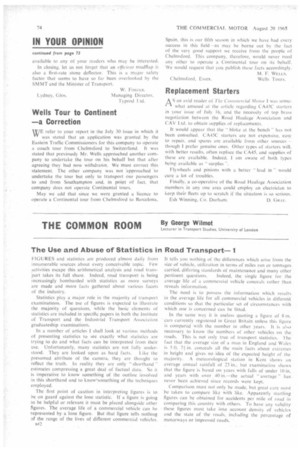THE COMMON ROOM
Page 76

If you've noticed an error in this article please click here to report it so we can fix it.
The Use and Abuse of Statistics in Road Transport— 1
FIGURES and statistics are produced almost daily front innumerable sources about every conceivable topic_ Few activities escape this arithmetical analysis and road transport takes its full share. Indeed, road transport is being increasingly bombarded with statistics as more surveys are made and more facts gathered about various facets of the industry. Statistics play a major role in the majority of transport examinations. The nse of figures is expected to illustrate the majority of questions, while the basic elements of statistics are included in specific papers in both the Institute of Transport and the Industrial Transport Association graduateship examination's. In a number of articles I shall look at various methods of presenting statistics to see exactly what statistics are trying to do and what facts can be interpreted from their use. Unfortunately, many statistics are not fully under stood. They are looked upon as hard facts. like the presumed attribute of the camera, they are thought to reflect the truth. In reality they are only "shorthand estimates compressing a great deal of factual data. So it is imperative to know something of the outline involved in this shorthand and to knowsomething of the techniques employed. The first point of caution in interpreting figures is to be on guard against the lone statistic. If a figure is going to be helpful or relevant it must be placed alongside other figures. The average life of a commercial vehicle can he represented by a lone figure. But that figure tells nothing of the range of the lives of different commercial vehicles. It tells you nothing of the differences which arise from the size of vehicle. utilization in terms of miles run or tonnages carried. differing standards of maintenance and many other pertinent questions. • Indeed, the single figure for the average life of a commercial vehicle conceals rather than reveals information. The need is to possess the information which results in the average life for all commercial vehicles in different conditions so that the particular set of circumstances with which one is concerned can be fitted. In the same way it is useless quoting a figure of 8 m. cars currently registered in Great Britain unless this figure is compared with the number in other years. It is also necessary to know the numbers of other vehicles on the roads. This is not only true of transport statistics. The fact that the average size of a man in England and Wales is 5 ft. 7-1in. conceals all the main facts about evtremes in height and gives no idea of the expected height of the majority. A meteorological station in Kent shows ail • average annual rainfall of 23 in.. but examination shows that the figure is based on years with falls of under 10 in. and years with over 40 in.—the actual "average " has never been achieved since records were kept. Comparison must not only be made, hut great care must be taken to compare like with like. Apparently startling figures can be obtained for accidents per mile of road in comparing this country with others. To have any validity these figures must take into account density of vehicles and the state of the roads, including the percentage of motorways or improved roads.




















































































































